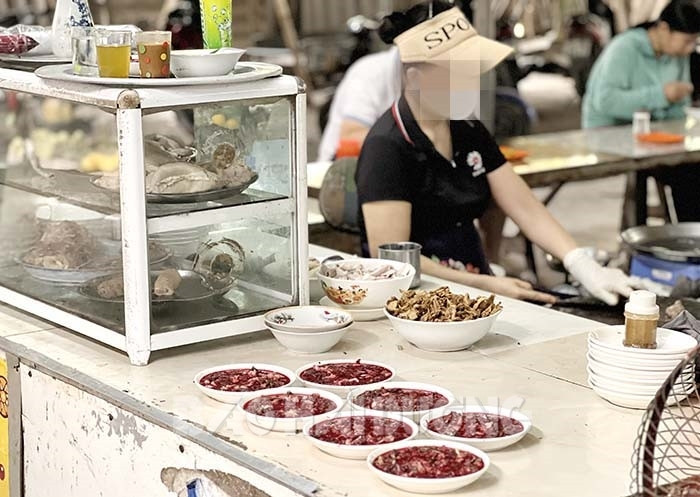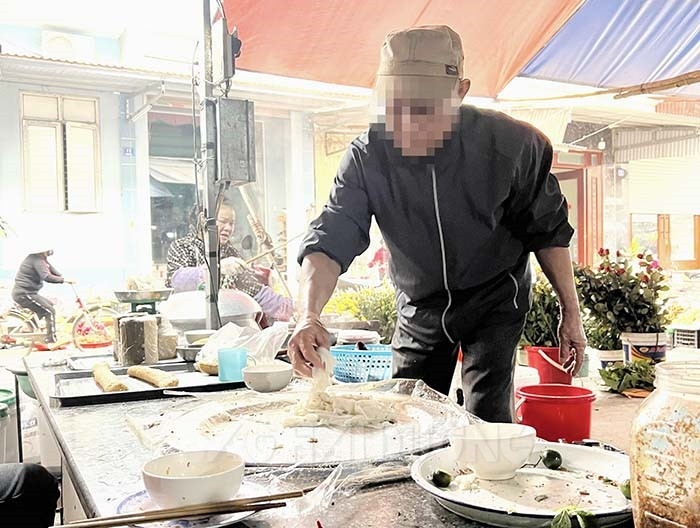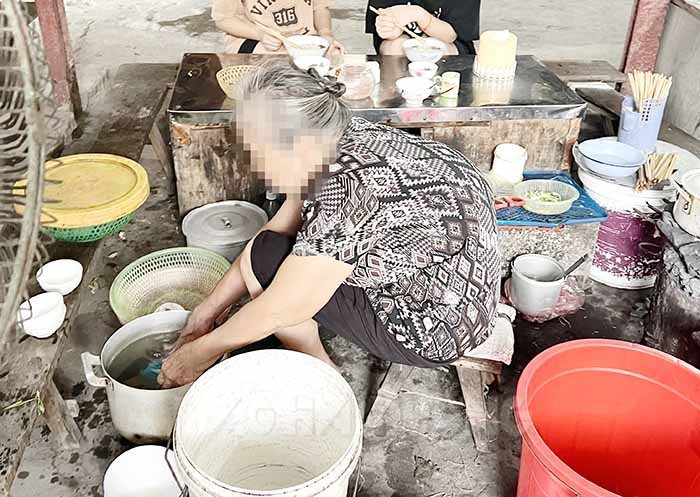Many eateries in the traditional markets in Hai Duong are damp and shabby. The conditions for food production and processing do not ensure food safety and hygiene.

A noodle and porridge shop owner at Cuoi Market (Gia Loc) displays many plates of blood pudding on the uncovered table.
Not hygienic
On the morning of May 7, posing as customers, a group of reporters from Hai Duong Newspaper stopped by a noodle and porridge shop in the middle of Cuoi Market (Gia Loc). In addition to the boiled pig organs kept in a glass cabinet, the shop owner displayed many plates of blood pudding right on the table without any cover, allowing flies to swarm. The shop was damp, the dining table, the plastic tubes holding chopsticks and spoons were dirty. A bucket of water that had turned dark brown was placed right next to a stack of washed and dried bowls.
Not far away, there was a shop selling noodle soup and rice noodles, but it was smaller. The space was cramped, the dining table was covered with corrugated iron but was covered with mold. Pots, pans, bowls, chopsticks, spoons... were placed on the dusty ground. After the customers finished eating, the owner washed the dishes in a pot placed on the ground with a small amount of water.
Leaving Cho Cuoi, the group of reporters continued to the central market of Nam Sach district to visit the eateries there. Stopping by a banh cuon stall owned by an elderly couple, we saw quite a few customers sitting and enjoying their food. Like many eateries in other traditional markets, this banh cuon stall was not clean. We ordered a meal, and the man nonchalantly used his bare hands to scoop the banh cuon onto a plate. His greasy hands continued to cut the sausage, reached into a plastic jar, picked up a handful of fried onions, and sprinkled them on the plate.

The owner of a banh cuon shop in Nam Sach district market uses his bare hands to serve the customers.
Many eateries in some traditional markets in the city area also do not ensure hygiene. At Thanh Binh market (Hai Duong city), it is not difficult to find shabby fixed or mobile food stalls with unsanitary business conditions.
The common characteristics of most eateries in traditional markets are cramped spaces, messy equipment, and lack of cleanliness. Many owners do not wear masks or gloves when preparing food for customers; leave raw and cooked food mixed together; use bare hands to pick up food; and slice raw and cooked food on the same cutting board. Some eateries use cooking oil repeatedly. Most eateries do not pay attention to collecting waste and treating wastewater, so they look unsightly and are the cause of flies, mosquitoes, and bacteria growing, invading food, and potentially causing illness for customers.
Not interested in management
Many food stall owners in the market, when asked, answered that they had never been trained in food safety and hygiene and that despite many years of business, there were few or no inspection teams. This shows that the inspection, propaganda, and reminders of food stall owners in the traditional market have not received due attention. "During the annual Food Safety Action Month, inspection teams from higher levels mainly inspect school kitchens and large eateries in shopping malls, while small eateries in the market are rarely inspected," informed the leader of a medical station in Cam Giang district.
Talking to a representative of a provincial professional agency to ask which unit is responsible for checking food safety at traditional markets, it was said that the decentralization of management is currently unclear. Furthermore, there are hundreds of traditional markets in the province, so it is difficult to arrange forces to maintain regular control.
In Hai Duong, there have been no mass poisoning cases related to food at the local market so far, but there are still small cases. Mr. NVQ (in Tu Ky) who has given up the habit of eating breakfast at the local market said: "I usually eat breakfast at the local market 1-3 times a week. More than 1 year ago, about 1 hour after finishing breakfast, I had a severe stomach ache, vomiting, headache, dizziness, and had to go to the emergency room." A representative of the Emergency Department of the Provincial General Hospital said that almost every year, there are patients coming to the emergency department due to food-related issues.
Most of the food stalls in the traditional markets do not ensure food safety and hygiene. Uncontrolled sources of raw materials combined with unsatisfactory business conditions pose a potential risk of food poisoning. Doctors say that unhygienic processed food is an ideal environment for harmful microorganisms to develop. When eating unhygienic food, you can get diseases such as diarrhea, stomach, duodenal, typhoid, dysentery, hepatitis A, severe poisoning, and even death.

Many eateries in the market are rundown, unsanitary, and the owners have not been trained in food safety and hygiene.
The above facts show that the control of food hygiene and safety at eateries in traditional markets needs more attention. The province needs to decentralize the management of food hygiene and safety at markets in a specific manner. Strengthen training, propaganda, raise awareness and responsibility of eatery owners in markets and people in ensuring food hygiene and safety, minimizing the risk of poisoning incidents...
DAWN